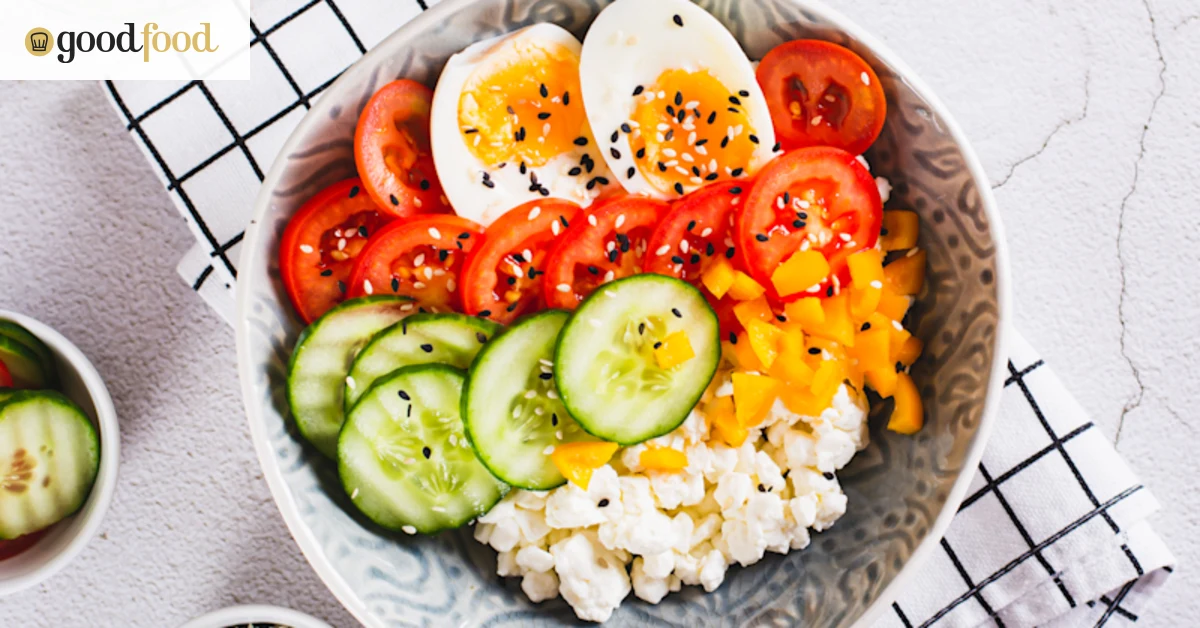This everyday ingredient is a protein powerhouse that’s cheaper and more versatile than chicken. No wonder it’s in hot demand.

If you watched your mum or grandmother diet in the ’80s, or come from a European family, chances are you have grown up seeing a tub of cottage cheese in the fridge.
Synonymous with all things dieting 40 years ago, while cottage cheese is not for everyone, if you do like it, it is certainly a nutritional powerhouse.
More recently, it is social media that has perpetuated a surge in demand for the humble tubs, with influencers using cottage cheese in a wide range of protein-packed recipes, which has sparked shortages in supermarkets across the country.
What is cottage cheese?
A soft, creamy cheese with a rough texture, unlike hard cheeses cottage cheese is not aged, and as such has a mild, nondescript flavour.
Cottage cheese is made using the curds of milk, and can be found in full fat and low-fat varieties in supermarkets.
Cottage cheese is actually an incredibly simple food, and you can even make your own simply by boiling milk and adding a little vinegar and salt until turns into a curd.
Homemade varieties are far less processed than typical commercial varieties, which tend to have a range of preservatives and additives to extend shelf life.
Why is cottage cheese a superfood?
While all cheese is nutritionally dense, cottage cheese in particular is one of the most nutrient dense foods you can include in your diet, especially if you are aiming to reduce calories, with a ½-cup serve containing just 100 calories along with more than 12g of protein per serve. Cottage cheese is also high in calcium, offering 100mg per ½-cup serve, as well as magnesium, Vitamin B12 and phosphorus.
Whilst the texture is not to everyone’s liking, cottage cheese is also extremely versatile and can be incorporated into a number of dishes, to boost the protein and nutrient content, and thanks to its simple flavour profile, means it can easily be added to a range of sauces, curries and baked goods.
How can I eat more cottage cheese?
The easiest way to add more cottage cheese into your diet is to add it to sandwiches, wraps, egg dishes, bowls and salads as a high-protein alternative to meat and chicken, at a budget-friendly price point. A well-balanced meal that will keep you full and satisfied for several hours will contain 20-30g of protein, which can be tricky to achieve via typical breakfast and lunch meals. Simply adding cottage cheese is an easy way to get an extra 10-12g of protein in a small volume of food.
Add it to sandwiches, wraps, egg dishes, bowls and salads as a high-protein alternative to meat and chicken, at a budget-friendly price point.
Between-meal snacks such as fruit, yoghurt, nuts and crackers too can offer very little protein. The addition of cottage cheese on crackers, or with fruit can again be an easy way to achieve a protein and calcium boost.
The flavour of cottage cheese can also be greatly enhanced with the addition of savoury vegetables, chutneys and relishes – think fermented vegetables, beetroot relish and flavoursome sauces, or if your preference is for sweeter foods, nut spreads, sliced fruit and a drizzle of honey or syrup. Here you can use cottage cheese to bump up the protein content of a meal while still getting plenty of flavour.
What if I don’t love it?
For those who are not keen on the taste or texture of cottage cheese, but keen to reap the nutritional benefits, cottage cheese can be used as a substitute for Greek yoghurt in many recipes, and complements recipes that have a cheese or egg base.
For example, combining cottage cheese with eggs in your favourite egg-based quiche or frittata will instantly boost the protein content of the dish. In creamy sauces that form the base for lasagne and pasta dishes cottage cheese blends in well with other dairy, as it does in baked foods like muffins and banana breads.
It works extremely well when combined with yoghurt or sour cream in dips, and more recently a number of influencers have used cottage cheese as a low-carb base for pancakes, pizza and flatbreads.
What if I cannot find it?
With the increase in demand for cottage cheese Australia wide, you may have noticed that the shelves may be empty. While there are other soft cheeses including ricotta and goat’s cheese, these lack the density of protein that cottage cheese does, and hence are not a direct swap. Nutritionally, high-protein Greek yoghurt has the closest nutritional profile, and can be used in some baked dishes, but the lack of consistency means that it will not combine well with eggs or as a sandwich topper.
The dietitian’s verdict
Cottage cheese is nutrient rich, convenient and a naturally high-protein natural food that can add calcium, protein and magnesium to the diet. It is also extremely versatile, and blends well with other ingredients to make healthy dips and sauces.
The formulations found in supermarkets are virtually identical, and even the regular options are relatively low in fat, so you really cannot go wrong, no matter which brand you find and enjoy.
The best recipes from Australia’s leading chefs straight to your inbox.


Leave a Reply